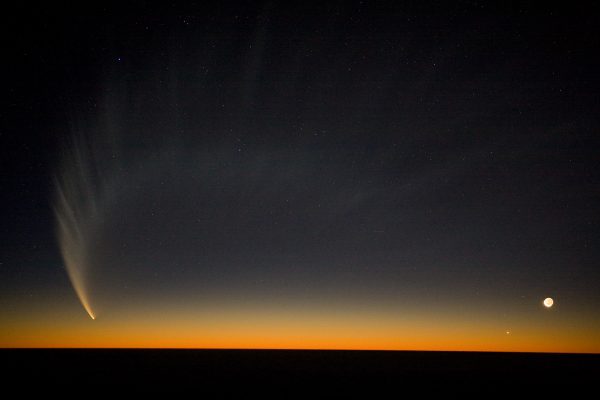Talking about astronomy

How coherent are we in our language when teaching and talking about astronomy?
By Nadine Afram
During a conference about ‚Education in Astrophysics and Astrobiology‘, the audience was asked to point North. Many stretched their arm and pointed into a direction horizontally in front of them. We were wrong. We should have pointed in front of us but downwards. There are studies (e.g., starting with the same experiment, https://facweb.northseattle.edu/ccummings/Survey%20of%20Anthropology/Boroditsky%20How%20Language%20Shapes%20Thought.pdf) about how this can be attributed to the language(s) we speak and how it influences our cognitive skills. It is said that ‚language shapes the most fundamental dimensions of the human experience: space, time, casualtiy and relationship to others.‘

Comet tails do not always point behind them as they travel. The direction of the (gas or dust) ‘tail’ changes depending on the position of the comet with respect to the Sun. The tail of the comet McNaught over the Pacific seen from Paranal in January 2007. The Moon is seen on the right. (Image ESO/H.H. Heyer)
If this is true for languages in general, it should also be valid for the words we use within one single language. How coherent are we when speaking about Astronomy? Do we mis-shape the conceptions of our audience by using inadequate language? One presenter (Nicoletta Lanciano, http://www.lettere.uniroma1.it/users/nicoletta-lanciano) provided us with a few examples:
We see the Sun that moves on the horizon and we speak still as if it is a central, static Earth and use sentences like ‚The Sun rises and the Sun sets‘. But we think of a planetary and dynamic Earth. We accept this co-existence in our mind and use a bi-logic. By using this imprecise language, we risk to put wrong conceptions into the minds of our audience. There are plenty other such examples: Our Sun is a star, but in songs or poetry, it is most often listed as something additional to ordinary stars: The moon, the Sun and the stars.
I searched for other formulations that could produce misconceptions in our minds, such as everyday words that are assigned to Astrophysical phenomena, like ‚black hole‘, implying a two-dimensional hole like a bathtub drain. Or the words comet ‚tail‘, a ‚pulsar‘, or Saturn’s ‚rings‘ (examples taken from p. 21/22 in https://physics.umaine.edu/wp-content/uploads/sites/80/2012/11/Sources-of-misconceptions.pdf). Sometimes there is no way around using these particular names or formulations. But once we can accept that these formulations could generate wrong images about the Astrophysical world around us, we may throw in an additional explanatory sentence to rectify our imperfect use of language.
Categories: Internal Newsletter

